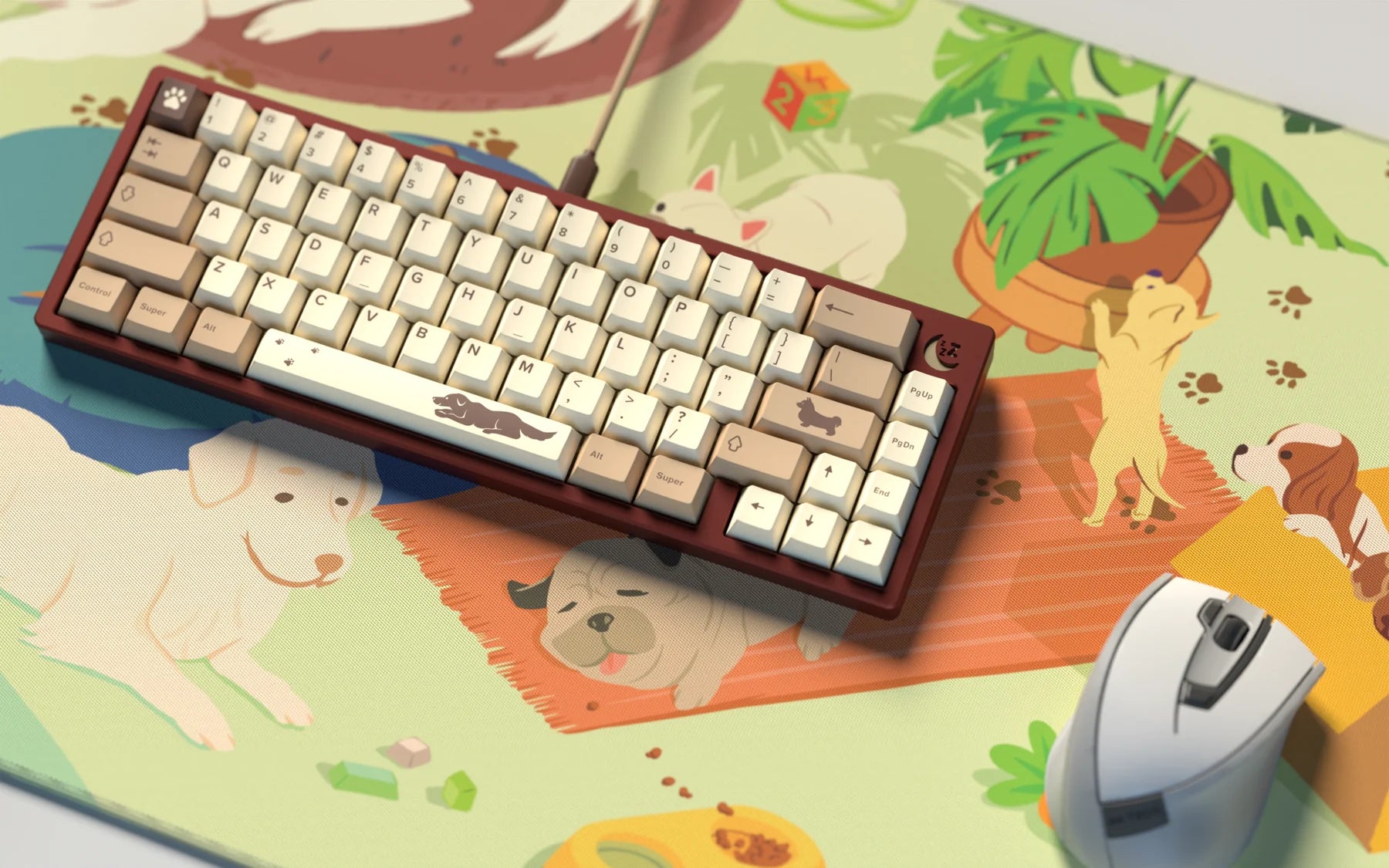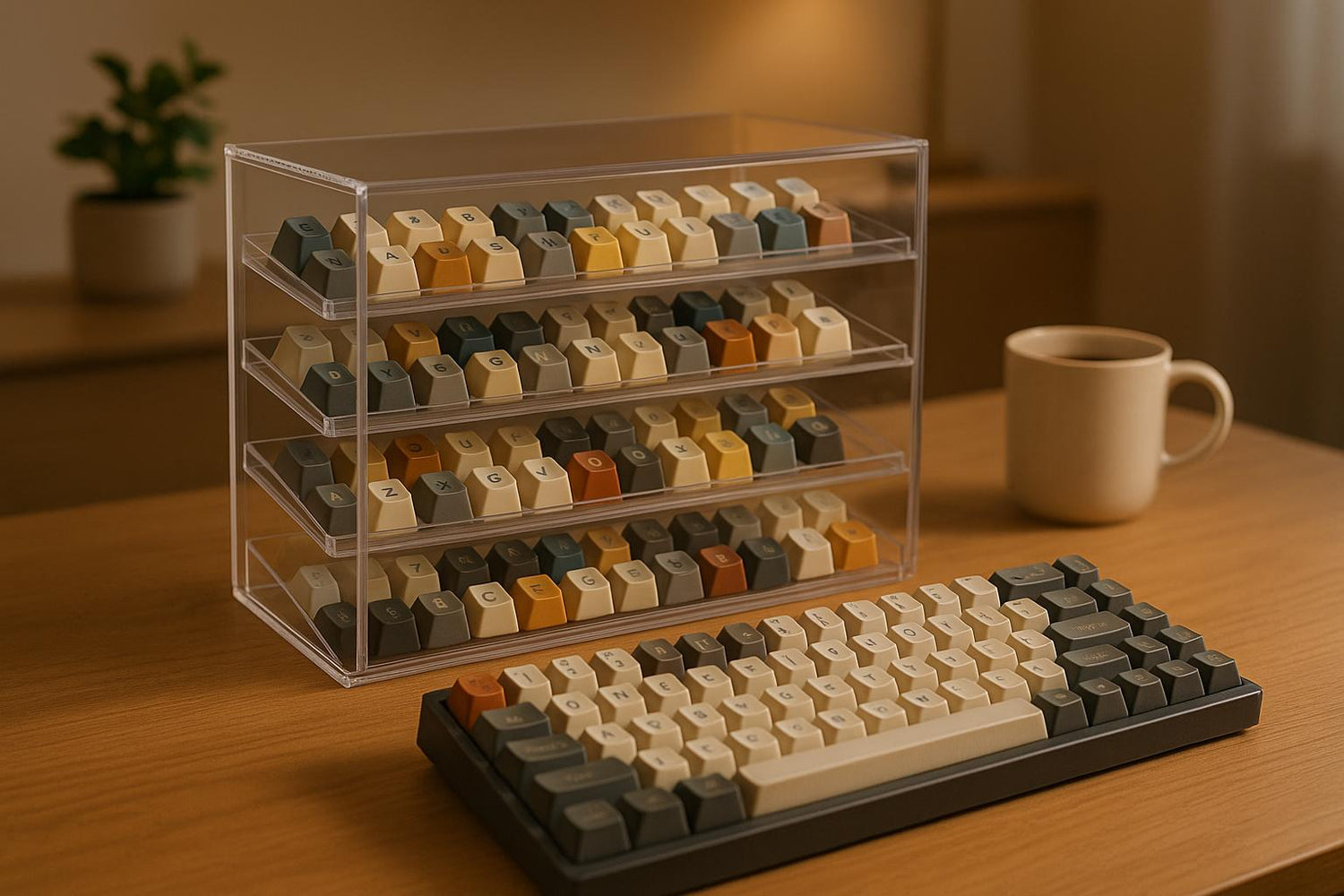Keycap collections are more than just accessories - they're personal, artistic, and often expensive investments. Proper storage and display aren't just about keeping things organized; they safeguard your collection from damage and can turn it into a stunning visual centerpiece.
Key Takeaways:
- Risks to Keycaps: Dust, UV rays, high humidity, and careless handling can damage keycaps. ABS keycaps are especially prone to yellowing, while vintage or artisan sets require extra care.
-
Storage Options:
- Ziplock Bags: Affordable but offer minimal protection.
- Plastic Bins: Stackable and clear for easy organization.
- Modular Trays: Premium protection but less space-efficient.
-
Display Options:
- Shadow Boxes: Wall-mounted displays for artisan or themed sets.
- Acrylic Cases: Dust-free desktop displays with full visibility.
- Rotating Stands: Dynamic displays for showcasing themes or colors.
- Managing Large Collections: Use digital catalogs to track sets and maximize space with stackable bins or under-desk drawers.
Whether you're starting small or managing an extensive collection, the right storage and display solutions keep your keycaps safe, organized, and ready to admire. Read on for detailed strategies tailored to different materials, budgets, and collection sizes.
Keycap Storage Requirements
Why Storage Matters
Storing your keycaps properly isn’t just about keeping things tidy - it’s about protecting their quality and extending their lifespan. The type of material your keycaps are made from heavily influences how they should be stored. For example, ABS keycaps, while affordable and widely used, are prone to yellowing when exposed to UV light and need extra care to avoid this. On the other hand, PBT keycaps are tougher and more resistant to wear, making them less demanding in terms of storage. Good storage practices also help maintain the visual appeal of your keycaps while preventing scratches, chips, or other damage. Let’s take a closer look at the challenges that come with storing different types of keycaps.
Common Storage Problems
The design and profile of keycaps can create unique storage challenges. SA keycaps, for instance, are tall with a spherical top, which means they require storage solutions that provide enough vertical space to avoid unnecessary pressure or damage. On the flip side, DSA keycaps, with their flat and uniform shape, are easier to store in compact spaces - but keeping them organized can be tricky. Cherry and OEM keycaps, with their sculpted designs, need extra clearance due to their varying heights.
As your collection grows, staying organized becomes even more challenging. Mixing different sets without a clear system can lead to frustration when you’re trying to reassemble a specific layout. Using labeled compartments, storage trays, or individual bags for each set can make a big difference. These strategies not only keep your collection in order but also help preserve your keycaps in top condition. Up next, we’ll dive into the best storage solutions to tackle these challenges.
GMK Keycap Tray Review

Keycap Storage Methods
Proper storage not only keeps your keycaps organized but also helps maintain their condition for long-term use or display.
Plastic Bins and Modular Trays
Clear latch boxes are a practical choice for storing keycaps. Their transparent design makes it easy to identify contents at a glance, while their stackable nature saves vertical space. To keep things even more organized, you can pair these bins with ziplock bags or smaller organizers to separate individual keycap sets.
Modular trays are another versatile option. These can be stacked within larger bins or used on their own, depending on the size of your collection. While some keycap sets, like the original GMK trays, come in oversized packaging, these are often not ideal for long-term storage. Many enthusiasts switch to compact modular trays for a more space-efficient solution.
If you're looking for affordable and space-saving alternatives, there are plenty of other storage methods to explore.
Ziplock Bags and Drawer Organizers
Ziplock bags are a budget-friendly way to store keycaps. Labeling them with masking tape and a sharpie ensures you can quickly identify each set. For added durability, mesh ziplock bags are a step up from standard ones, offering better protection and organization for your collection.
Drawer organizers are perfect for separating keycaps by profile. For example, you can dedicate specific compartments to GMK/Cherry profile keycaps and others to SA or different profiles. This makes it easier to find the right set when you're customizing or updating your keyboard layout.
Keycap Display Options
Storing keycaps keeps them organized and safe, but displaying them takes your collection to the next level. A well-thought-out display can turn your keycaps into eye-catching decor while keeping them protected from potential damage.
Shadow Boxes and Display Frames
Shadow boxes are perfect for creating wall-mounted displays that showcase your keycaps as pieces of art. These frames are especially ideal for artisan keycaps or themed sets that deserve to stand out. You can even match the frame’s color and design to your room’s style, seamlessly integrating your collection into your space.
To mount your keycaps securely, use stretch string in an "X" pattern to hold them in place. For heavier keycaps, position them on the bottom lip of the box for added support.
Display frames offer flexibility in how you present your collection. You can set them on desks or shelves like photo frames or hang them on walls for a more traditional look.
Acrylic Cases and Rotating Stands
For those who prefer desktop displays, acrylic cases and rotating stands provide an excellent balance of aesthetics and practicality. Clear acrylic cases allow full visibility of your keycaps while protecting them from dust and damage. Many of these cases also double as storage, making them a great choice for keycaps you use frequently.
Switch testers are another affordable option for displaying artisan keycaps. These testers, available for around $4–$5, come in various slot sizes and keep your keycaps secure while on display.
If you’re looking for something more dynamic, rotating stands add movement to your display. These stands slowly spin, showcasing your keycaps from every angle. Arranging keycaps by color or theme on these stands can enhance the overall look of your desk.
For more specialized displays, you’ll find options ranging from basic mechanical keyboard frames priced at $24.99 to handcrafted resin boxes with magnetic lids for $54.00. The ASTRA II 5x8 Artisan Keycap Box, featuring 40 slots, a clear lid, and a stand, costs $34.27 and offers a polished display solution for larger collections.
UV and Dust Protection
No matter how you choose to display your keycaps, protecting them from environmental damage is crucial. UV rays can fade and discolor vibrant keycaps or those with special coatings, so it’s best to keep displays out of direct sunlight or use UV-filtering glass.
Dust is another concern for displayed keycaps. Closed cases with snug lids are great for preventing dust buildup and reducing the need for frequent cleaning. For open displays, regular maintenance is key. Gently cleaning your keycaps from time to time will keep them looking their best.
Rotating keycaps in open displays can also help minimize wear and ensure even exposure. Whether you plan to use your keycaps again or keep them as collectibles, proper care will preserve their appearance and functionality for years to come.
sbb-itb-3cb9615
Managing Large Collections
When your keycap collection starts to grow beyond just a few sets, keeping everything organized becomes a real challenge. Without a solid system for tracking and storing your collection, you can quickly find yourself struggling to locate specific sets or, worse, damaging them unintentionally. Here’s how to stay on top of it all.
Tracking Your Collection
A digital catalog is your best friend when it comes to managing a large keycap collection. A simple spreadsheet with columns for details like the set name, manufacturer, profile, color scheme, purchase date, and storage location can save you from endless rummaging. It’s a straightforward way to quickly search for a specific set without needing to open every box or drawer.
Want to take it a step further? Add photo logs. Snap clear pictures of each keycap set and attach them to your catalog. This visual reference is especially helpful for collections that include artisan keycaps or sets with subtle differences. It makes identifying and locating keycaps much easier.
For larger collections, consider tracking additional details like condition, estimated value, and completeness. These details can help you decide which sets to display, sell, or trade. To make your system seamless, ensure your digital catalog matches your physical storage labels. For instance, if you label a container “GMK Botanical - Row 15,” make sure your spreadsheet uses the same identifier.
Consistency is key to keeping your tracking system useful. Dedicate time - monthly, if possible - to update your catalog with new purchases, changes in storage locations, or any other adjustments. A well-maintained system ensures your collection stays easy to manage.
Once your collection is well-documented, the next challenge is figuring out how to store it all efficiently.
Maximizing Storage Space
With an updated catalog in hand, organizing your physical storage becomes much simpler. Start by making the most of vertical space. Stackable transparent storage boxes are a great option because they let you see what’s inside without having to open each one. This saves both time and effort when you’re looking for a specific set.
For smaller spaces, consider under-desk drawers or rolling carts. These mobile storage solutions keep your collection accessible without cluttering your workspace. Look for options with compartments or adjustable dividers to fit sets of varying sizes.
To prevent damage, use keycap storage trays with individual slots. These trays not only protect keycaps from scratching against each other but also stack neatly, making them a practical choice for valuable sets.
If you’re proud of your collection, why not show it off? Wall-mounted displays like floating shelves or shadow boxes let you showcase your favorite sets while freeing up desk and floor space. Arrange them at different heights for a visually appealing setup that doesn’t interfere with your workspace.
Environmental factors also play a big role in preserving your collection. Keep humidity levels between 40–60% and avoid areas prone to extreme temperature changes, like attics or basements. Direct sunlight can fade keycap colors, so store them away from windows. For dust protection, sealed containers work best for long-term storage, while individual dust bags are handy for sets you use frequently.
Lastly, don’t forget about cable management if you’re storing keyboards along with your keycaps. Detach cables when possible, coil them neatly with soft velcro ties, and store them in labeled bags. This prevents tangling and makes it easier to set up when you’re ready to use a specific board.
Managing a large collection takes effort, but with regular updates, consistent labeling, and smart use of space, you can keep everything organized and accessible. It’s all about creating a system that works for you and sticking to it.
Storage Method Comparison
Before diving into specific products, it’s helpful to compare how different storage methods stack up in terms of protection, space efficiency, and cost. With so many options out there, figuring out the best way to store your keycap collection can feel daunting. Each method has its upsides and downsides, and the right choice depends on your budget, space, and personal preferences.
Pros and Cons of Each Method
The three most common storage methods cater to varying needs and budgets. Let’s break them down:
Ziplock bags are the go-to for collectors looking to save space and money. As one enthusiast shares:
"I chuck my sets in zip log bags, label them with a sharpie and toss them in a large plastic tub." - givemeyourshoes
This method is incredibly affordable and offers unmatched space efficiency. But there’s a trade-off: the thin plastic provides minimal protection, and as your collection grows, finding specific keycaps can become a hassle.
Plastic bins strike a balance between cost and functionality. They’re great when paired with ziplock bags for added organization. The clear plastic makes it easy to see what’s inside without opening every container. However, bins do take up more space compared to bags alone.
Modular trays sit at the premium end of the spectrum. JTK trays are especially popular in the aftermarket, offering individual slots for each keycap. One user highlights their convenience:
"I like trays for a more swift transaction between two sets." - skepp
Trays provide excellent protection, keeping keycaps from rubbing against each other, and make it easy to swap between sets. However, they come with a steep price tag and are far less space-efficient, especially for larger collections.
Here’s a side-by-side comparison of these methods:
| Storage Method | Protection Level | Space Efficiency | Cost | Access Speed | Best For |
|---|---|---|---|---|---|
| Ziplock Bags | Low | Excellent | Very Low | Slow | Budget-conscious collectors |
| Plastic Bins | Medium | Good | Low | Medium | General storage needs |
| Modular Trays | Excellent | Poor | High | Fast | Premium sets, frequent swapping |
The space drawback of trays is particularly noticeable. As one collector puts it:
"Trays are space-inefficient in limited areas." - dwarflemur
Many enthusiasts find that combining methods works best. For example, you might store your most valuable or frequently used sets in trays, while keeping backup or less valuable sets in labeled bags placed inside bins. This approach balances protection, cost, and practicality.
Modern storage trends lean toward maximizing efficiency. Keycap expert Manofinterests explains:
"These days, I think it's either mason jars, ziplock bags, or small plastic storage containers/organizers for the best storage to space ratio." - Manofinterests
Ultimately, the best method depends on your needs. If you rarely switch keycaps and have limited space, ziplock bags are hard to beat. If you frequently swap sets and own high-value keycaps, trays are worth the investment despite their space demands. For most collectors, plastic bins with organized bags inside hit the sweet spot of affordability, protection, and accessibility.
It’s also smart to think ahead. What works for a small collection might not scale well as your collection grows. Starting with a system that’s efficient and expandable can save you from a major reorganization down the road.
KeebsForAll Storage Solutions

For those who value both functionality and aesthetics, KeebsForAll offers storage solutions that not only protect but also enhance your keycap collection. Known for its dedication to quality and community, KeebsForAll ensures your keycaps stay organized and well-preserved while maintaining the brand's signature style.
Built on Quality and Community Values
KeebsForAll's reputation for excellence is evident in products like the kfaPBT keycaps, crafted from durable PBT material with 1.5mm thickness and dye-sub printing. This same attention to detail extends to their storage accessories. Beyond their product lineup, KeebsForAll supports the mechanical keyboard community through the KFA Marketplace (kfamarketplace.com), a platform for buying and selling second-hand keyboards. This marketplace highlights the importance of quality accessories and proper product care, values that are seamlessly integrated into their storage solutions designed to protect and showcase your keycap collection.
Thoughtful Design and Budget-Friendly Options
KeebsForAll blends practicality with affordability, ensuring their storage products meet the needs of keyboard enthusiasts. Collaborating with manufacturers, they create storage options tailored to collectors while keeping costs accessible. For example, KFA Cherry Profile Blank PBT Keysets are priced at $36.00, and kfaPBT Cardinal Keycaps are available for $78.00. These pricing strategies make it easier for hobbyists to preserve and display their collections without overspending.
With the same high standards found in their keycap designs, KeebsForAll’s storage solutions deliver reliability and style, making them a trusted choice for enthusiasts.
Conclusion
Storing and displaying your keycap collection properly can elevate your hobby to the next level. The right solution depends on your collection's size, your budget, and how you want to showcase your prized pieces.
For those on a budget, simple options like ziplock bags or drawer organizers can get the job done. If you frequently attend events or need portability, storage boxes designed for travel are a practical choice. To highlight your collection, consider display solutions like shadow boxes or acrylic cases, which not only enhance their visual appeal but also help preserve their condition. As your collection expands, tools like adjustable dividers and customizable layouts can help you stay organized.
KeebsForAll has a range of products tailored to meet these needs, offering solutions for everyone - from beginners just starting out to seasoned collectors with extensive inventories. Their focus on community ensures that storage options remain accessible, no matter where you are in your collecting journey.
FAQs
What’s the best way to store ABS keycaps to keep them in great condition?
To keep your ABS keycaps in top shape, store them in dustproof display cases or sealed storage boxes that block UV rays. UV exposure can lead to yellowing and weaken the plastic over time. It's also essential to keep them out of direct sunlight and in an environment with stable humidity levels - ideally between 40–60% - to prevent warping or cracking. Maintaining a consistent room temperature is equally important to avoid material degradation.
If you want to show off your collection, opt for display cases that combine protection with a sleek presentation. Taking these precautions will help your ABS keycaps stay in great condition for years to come.
What’s the best way to organize and keep track of a large keycap collection?
To keep your keycap collection organized and easy to manage, start with clear storage options like labeled containers, drawer dividers, or display cases. Sorting your keycaps by size, profile, or set can help you quickly find what you need without digging through everything.
Consider creating a digital inventory using a spreadsheet or a collection management app. Include details like the set name, quantity, and compatibility, and make it a habit to update it regularly. Adding photos to your inventory can also help you avoid buying duplicates and make searching for specific keycaps a breeze.
For long-term care, store your keycaps in a climate-controlled environment to shield them from heat, humidity, and direct sunlight. This will help maintain their condition and keep your collection looking great over time.
What are the best ways to display keycaps while keeping them protected from damage?
To display your keycaps in a way that's both eye-catching and secure, try using clear acrylic or glass display cases. These cases not only protect your collection from dust, moisture, and UV light but also allow you to admire your keycaps without obstruction. If you're looking to add a bit of flair, consider custom display stands or shadow boxes crafted from wood or acrylic. These options not only emphasize the intricate details of your keycaps but also keep them organized and safe. Whether you're a seasoned collector or just beginning, these setups are a great way to showcase your collection.



![[Pre-Order] Autumn Leaves PBT Keycaps - KeebsForAll](http://keebsforall.com/cdn/shop/products/DSC09732.jpg?v=1676148273)






Leave a comment
This site is protected by hCaptcha and the hCaptcha Privacy Policy and Terms of Service apply.